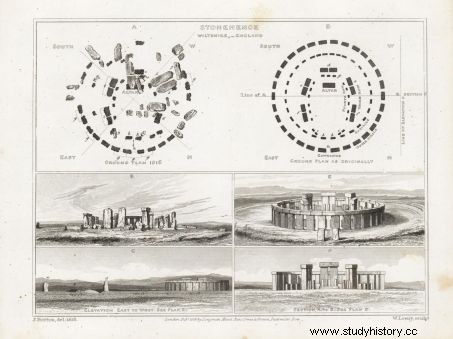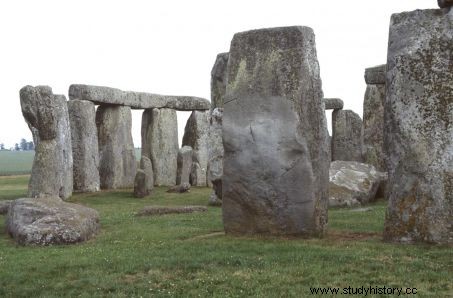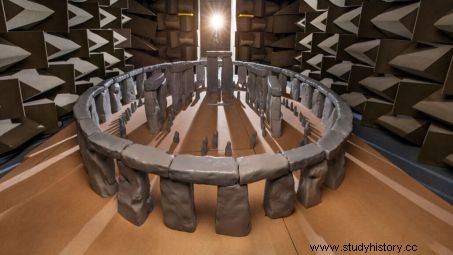With more than a million visitors a year, Stonehenge, a set of megaliths erected in the middle of a plain in southern England during the Neolithic period, is undeniably a fascinating monument. Still shrouded in mystery and legend, the site nevertheless gradually reveals its secrets to archaeologists.

Known for many centuries and studied since 1901, the site of Stonehenge still remains one of the most enigmatic archaeological sites in the world.
It is fascinating to see the extent to which Stonehenge, a famous megalithic monument dating from the Neolithic to the Bronze Age, still and always has surprises in store for us more than a century after the first work of archaeologists intended to unravel its mysteries (Professor Gowland conducted the first scientific excavations from 1901). Located in the county of Wiltshire, England, a few kilometers from the city of Salisbury, Stonehenge is indeed the subject of very few certainties, starting with its dating and its original function.
A construction spanning several thousand years
The consensus is that the site, even before the erection of any monument, was already occupied between 10,000 and 5,500 years ago, as the traces of wooden posts suggest. The construction of the stone structure, which probably began in the 3rd millennium BC, was probably carried out in four stages with materials of various origins.
- During the 3rd millennium BC, a circular embankment and a ditch 100 meters in diameter were built. The main entrance to this enclosure faces northeast while a second, smaller entrance points south. At the bottom of the ditch were discovered the remains of Neolithic tools used for digging, but also the skeleton of a man in his thirties, riddled with several arrows. Unearthed in 1978, the latter has been nicknamed "the archer of Stonehenge" and is on display at the Salisbury Museum. He would have died around 2,300 BC. Finally, for this first period of construction (between 2800 and 2100 BC, called Stonehenge I), there are 56 large-scale cavities forming a vast circle inside from the earth enclosure. Filled with chalk, charcoal, charred human bones or small bone or flint objects, these holes called "Aubrey holes" (Aubrey holes ) could be similar to tombs.
- At the beginning of the 2nd millennium BC (around 2100-2000 BC, so-called Stonehenge II period), at least 80 blue stones or bluestones , eruptive rocks collected in Wales, appear to have been arranged to form two concentric circles arranged inside the circle of sarsen current. If the circles have now completely disappeared, several blue stones were reused during the third phase of construction of the building, in the Bronze Age.
- Around 1,400 BC (during Stonehenge III, which is understood to be between 2,000 and 1,100 BC), the blue stones were therefore removed and replaced by a circle of 30 sandstone monoliths local, nicknamed sarsens . Forty blue stones are collected to form a circle inside the first one. In the middle, five trilithons seven meters high, now aligned in a horseshoe, are erected. In the center is a flat stone of green sandstone shining in the sun, "the Altar Stone" (Altar Stone ) brought from Pembrokeshire and today hardly visible for the visitor, who can no longer enter directly inside the monument but only admire it from a good distance.
- Finally, the skeleton of a young boy who probably lived between 780 and 410 BC was found in a large trench dated to the end of the 7th century BC. This last modification corresponds to the last period of shaping the monument, dubbed Stonehenge IV.

Original plan and elevation, and ruins from 1816. Copper engraving by W. Lowry after an illustration by J. Britton from Abraham Rees' Cyclopedia or Universal Dictionary, London, 1816 Credits:Florilegius/Leemage
What was Stonehenge used for?
In 1640, English writer John Aubrey speculated that Stonehenge was a druidic site. Taken up by the antiquarian William Stukeley in the century, this theory, erroneous, still has a hard tooth today. The Druids only appeared with the Celtic or Gallic peoples, in the Iron Age, around the 5th century BC. We know, however, with almost certainty that the place was above all a cemetery. , as evidenced by many often charred human bones found in burial mounds and other cavities.
Links with astronomy have also been put forward by several researchers. It has been argued on several occasions that the place may have served as an "observatory", but this thesis is now controversial. Stonehenge would more likely have been a ceremonial and/or important gathering place, especially during the summer solstice and especially the winter solstice, as more recent studies suggest (archaeologist Mike Parker Pearson has worked extensively on this question). In a Neolithic society where agriculture played a capital role, the shortest day of the year had to have a very large religious and symbolic dimension. The wait for the sun to return and for the seeds to germinate in the fall were probably more important at this time of year than at the summer solstice, when it is all about the harvest.
The origin of the Stonehenge megaliths finally discovered
It is fascinating to see the extent to which Stonehenge, a famous megalithic monument dating from the Neolithic to the Bronze Age, still and always has surprises in store for us more than a century after the first work of archaeologists intended to unravel its mysteries (Professor Gowland conducted the first scientific excavations from 1901). Located in the county of Wiltshire, England, a few kilometers from the city of Salisbury, Stonehenge is indeed the subject of very few certainties, starting with its dating and its original function.
A construction spanning several thousand years
The consensus is that the site, even before the erection of any monument, was already occupied between 10,000 and 5,500 years ago, as the traces of wooden posts suggest. The construction of the stone structure, which probably began in the 3rd millennium BC, was probably carried out in four stages with materials of various origins.
- During the 3rd millennium BC, a circular embankment and a ditch 100 meters in diameter were built. The main entrance to this enclosure faces northeast while a second, smaller entrance points south. At the bottom of the ditch were discovered the remains of Neolithic tools used for digging, but also the skeleton of a man in his thirties, riddled with several arrows. Unearthed in 1978, the latter has been nicknamed "the archer of Stonehenge" and is on display at the Salisbury Museum. He would have died around 2,300 BC. Finally, for this first period of construction (between 2800 and 2100 BC, called Stonehenge I), there are 56 large-scale cavities forming a vast circle inside from the earth enclosure. Filled with chalk, charcoal, charred human bones or small bone or flint objects, these holes called "Aubrey holes" (Aubrey holes ) could be similar to tombs.
- At the beginning of the 2nd millennium BC (around 2100-2000 BC, so-called Stonehenge II period), at least 80 blue stones or bluestones , eruptive rocks collected in Wales, appear to have been arranged to form two concentric circles arranged inside the circle of sarsen current. If the circles have now completely disappeared, several blue stones were reused during the third phase of construction of the building, in the Bronze Age.
- Around 1,400 BC (during Stonehenge III, which is understood to be between 2,000 and 1,100 BC), the blue stones were therefore removed and replaced by a circle of 30 sandstone monoliths local, nicknamed sarsens . Forty blue stones are collected to form a circle inside the first one. In the middle, five trilithons seven meters high, now aligned in a horseshoe, are erected. In the center is a flat stone of green sandstone shining in the sun, "the Altar Stone" (Altar Stone ) brought from Pembrokeshire and today hardly visible for the visitor, who can no longer enter directly inside the monument but only admire it from a good distance.
- Finally, the skeleton of a young boy who probably lived between 780 and 410 BC was found in a large trench dated to the end of the 7th century BC. This last modification corresponds to the last period of shaping the monument, dubbed Stonehenge IV.

Original plan and elevation, and ruins from 1816. Copperplate engraving by W. Lowry after an illustration by J. Britton from Cyclopedia or Universal Dictionary from 'Abraham Rees, London, 1816. Credits:Florilegius/Leemage
What was Stonehenge used for?
In 1640, English writer John Aubrey speculated that Stonehenge was a druidic site. Taken up by the antiquarian William Stukeley in the century, this theory, erroneous, still has a hard tooth today. The Druids only appeared with the Celtic or Gallic peoples, in the Iron Age, around the 5th century BC. We know, however, with almost certainty that the place was above all a cemetery. , as evidenced by many often charred human bones found in burial mounds and other cavities.
Links with astronomy have also been put forward by several researchers. It has been argued on several occasions that the place may have served as an "observatory", but this thesis is now controversial. Stonehenge would more likely have been a ceremonial and/or important gathering place, especially during the summer solstice and especially the winter solstice, as more recent studies suggest (archaeologist Mike Parker Pearson has worked extensively on this question). In a Neolithic society where agriculture played a capital role, the shortest day of the year had to have a very large religious and symbolic dimension. The wait for the sun to return and for the seeds to germinate in the fall were probably more important at this time of year than at the summer solstice, when it is all about the harvest.
The origin of the Stonehenge megaliths finally discovered
Where the Stonehenge stones came from, as well as how the people of the time brought them to the site, until recently remained yet another topic of discussion and research in the archaeological community. In July 2020, a study seems to have put an end to the debate. Geochemical tests indicate that 50 of the 52 pale gray sandstone megaliths at Stonehenge – the famous sarsens –, share a common origin:the site of West Woods, a tiny wood located about 25 km from the famous structure, on the edge of Marlborough Downs, Wiltshire. All would have been erected around the same time, around 2,500 BC.

Credits:Aglileo Collection/Aurimages via AFP
Archaeologists had been able to identify a few years ago the origin of the smallest stones of the monument, the bluestones . That of the most imposing megaliths, however, remained enigmatic. As seen in the site timeline, Stonehenge is made up of two different rock types:megaliths, which are blocks of sarsen sandstone , while the rocks of smaller size, arranged in a circle and a horseshoe inside the megalithic ring and known as bluestones, or blue stones, are made of dolerite (igneous rock similar to basalt) and rhyolite (fine-grained volcanic rock).
Numerous studies and the discovery of ancient quarries had eventually led researchers to consider that the magmatic blue stones came from the Preseli Hills, in south-west Wales, more than 200 kilometers from the site. Regarding the megaliths, only one study has so far focused on their origin.
Surprising acoustic properties
A study published in September 2020 this time revealed an astonishing property of the monument that had been ignored until then. Acousticians Trevor Cox and Bruno Fazenda, from the University of Salford in the North West of England, assisted by archaeologist Susan Greaney, ventured to reproduce the acoustics of the place thanks to a model at the 1:12 scale. Called "Minihenge", this reproduction allowed them to test the acoustic properties of the building when its 157 stones were all still standing. Verdict:Around 4,000 years ago, Stonehenge formed an acoustic space that amplified voices and enhanced the sound of any music played for people standing within the massive stone circle.

To understand how sounds resonated in the monument when it was still complete, the team of researchers from Salford developed a model of the site. Credits:Acoustics Research Center/Univ. of Salford
Due to the way the stones were placed, this word or music would not have been projected beyond the monument's enclosure, into the surrounding nature, and would have been barely distinguishable by people standing nearby. . The reverberation would have been such that it would have enhanced verbal communication and music inside the monument in a way quite similar to the effects of reverb used in modern music pieces. However, there would have been no echo, again thanks to the particular arrangement of the stones.
A new prehistoric structure discovered in 2020
In June 2020, the Scottish University of Saint Andrews announced that they had unearthed a unique prehistoric structure near the megalithic monument. Forming a circle more than two kilometers in diameter, it today takes the form of 20 massive excavations, more than ten meters in diameter and five meters deep. It takes shape all around the Neolithic enclosure of Durrington Walls and the site of Woodhenge, about three kilometers from Stonehenge. They are said to have been dug over 4,500 years ago, around the time Durrington Walls was erected. According to archaeologists, these excavations would have marked the limits of a sacred area in the Neolithic era, associated with the appearance of the first farmers in Britain and sometimes the erection of very imposing ritual structures.
The road near Stonehenge will soon be replaced by a less invasive tunnel
Stonehenge is now managed by English Heritage, an independent public body responsible for managing England's historic heritage, and listed as a UNESCO World Heritage Site. Despite this classification, a fast track still passes near the site today, polluting this archaeological setting in several ways (which is therefore not only made up of the circle of stones, as we will have understood). In November 2020, the British Ministry of Transport nevertheless approved the project of a road tunnel which will replace the current road and thus restore the site to a less noisy environment and closer to its original state. But before digging, you have to dig! A vast archeology program is therefore scheduled beforehand. As part of this "A303" road project, Wessex Archeology will be responsible for studying the surroundings of Stonehenge affected by the development of the new route, in collaboration with... a French institution, the National Institute for Preventive Archaeological Research (Inrap)!
